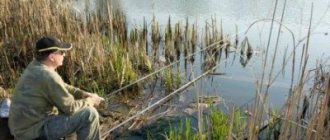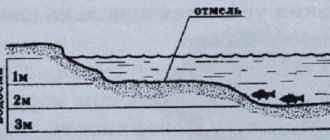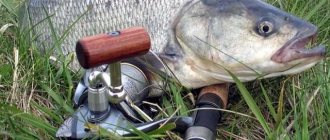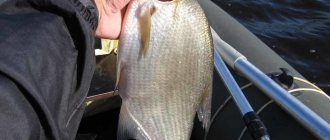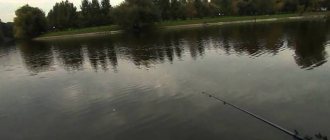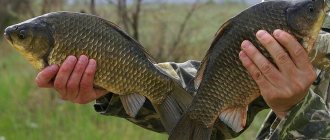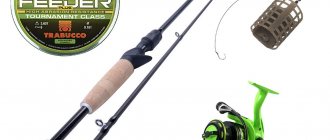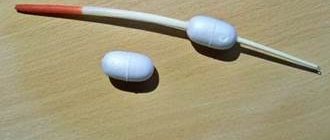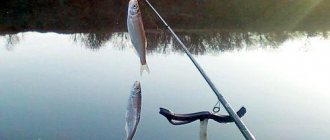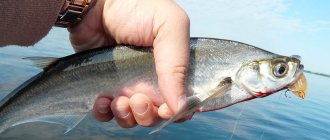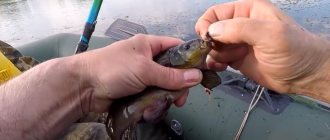After a lull in winter, all anglers are looking forward to spring. With the awakening of nature, the fish becomes more active, it is hungry and weak. Any bait or groundbait will help her gain strength before spawning. And therefore, catching bream in the spring with a float rod is successful, starting with under-ice bites in March and the spawning period after the opening of reservoirs.
Bottom fish bream is found not only in small and large rivers, but also in lakes and reservoirs. At any time of the year it sticks to the bottom, whether in deep or shallow places. At the beginning of spring, when the snow begins to melt, bream emerges from their wintering holes and migrates, preparing for the upcoming spawning.
The fish's hunger is due to the fact that it is necessary to gain strength before spawning. On lakes, bream is found in shallows and areas overgrown with algae, where it actively feeds. In reservoirs with running water, bream tries to be closer to the shore, going to a depth of one to three meters, where the current is weaker and there is plenty of food. The best tackle for catching bream in the spring will be a float rod, because you will have to fish from the shore.
Catching bream in March with a float rod
In early March, when the ice on rivers and lakes melts, fishermen rush for bream. At this time, he is more willing to take bait. On the last ice, white fish are caught using winter float tackle and a nod, as well as in open areas using a summer float rod. To attach a fishing rod use:
- large bloodworm;
- red worm;
- maggot;
- semolina mash.
Complementary feeding mixtures attract the attention of bream in March and force it to remain in place for a long time at a depth of two to four meters.
Read also: Everything about bream fishing from A to Z
It is better to fish early in the morning, as soon as the sun rises, because at dusk the fish move away from the shore. You can catch bream at night, but the bite later than eleven in the evening until two in the morning is not always stable. Tackle for bream is chosen with high-quality fishing line, since the fish uses remarkable force while fishing, trying to escape.
Going fishing with Normund. Fishing for bream with a fly rod in March video.
Catching bream in April with a float rod
It is safer to catch bream in April in reservoirs with standing water than in rivers.
The bite on the lake is stable and successful, because the fish come closer to the shore to spawn. When the spilled water warms up well, the bream moves to the grassy shallow water. If there are no bays, then it is nearby at a depth of one and a half meters. Read also: With a feeder for April bream
To fish from the shore, you need a fishing rod with a long rod and a flying float. Luck in April depends on the weather. Bream will prefer warm water, but will go deeper when the temperature drops. A serious bite is successful at water temperatures of eight to ten degrees Celsius.
It is imperative to feed fish in lakes in April in small portions. The nutrient balls should not fly into pieces when cast. But you shouldn’t overfeed the area, otherwise the bream will become lethargic and the bites will be weak.
This is interesting: Pea mastyrka for bream
On the river in quiet bays you can find bream; it is located on the border between current and standing water. The aggressiveness of the fish is taken into account when choosing a fishing line for a fishing rod. It should not be more than 0.25 millimeters. And the hook should be of medium thickness, but reliable and strong.
The bait is prepared from a mixture of peas with pearl barley and oatmeal or bloodworms with soil, slightly flavored. Nutrient balls are thrown upstream. In deep places, feeders are lowered.
Secrets of catching bream in April using a float rod on the video channel.
Where to look for bream in spring
Fishing for bream in the spring should take place along the coastline, where there are enough depressions and depressions. The fish moves away from the fast current into small backwaters and river pockets, where the water settles a little and contains less turbidity. Flocks look for secluded corners in flooded bushes, last year's grass and snags.
You can look for bream in the spring at the very edge of the algae. The fish move through the muddy water closer to the shore and grass thickets in search of food. If you manage to feed such a place, then an experienced fisherman can collect a good catch.
Search conditions in May are constantly changing and depend on water levels and temperatures. Flocks move chaotically in search of food. Only with the onset of stable weather and an acceptable water level does the bream begin to feed cyclically. At this time, fish come out from the depths at night closer to the shore and it becomes easier to catch trophy specimens.
When the flood subsides and the water clears, the flocks move closer to areas with rip currents. In such places there are natural feeders into which insects, worms and other food are carried away by the water flow.
Read more about how to fish with a feeder in spring and what nuances should be taken into account.
Catching bream in May with a float rod
In May, bream chooses river mouths for habitat, and in reservoirs - holes or places near dams.
Since the ban on catching bream from a boat is in effect from April to early June, they catch it with a fishing rod from the shore. The gear is selected with a long rod, up to seven meters, a strong reel and fishing line. This is interesting: With a feeder for May bream
To catch bream in May, you need to choose places on reservoirs where the bottom is rocky or clayey, and the depth starts from one meter or more. Large specimens are found near snags, boulders, and on sandbanks one and a half meters deep. The bite is intense where the current is weak. If the flood lasts until the end of May, then bream fishing occurs with varying degrees of success.
Read also: How to catch bream with a Bolognese fishing rod
Only after the river enters the channel is it easier to catch fish. Luck accompanies the one who finds the moving places of a school of bream. Fish trails where there is live food, where the water is warmer and cleaner. In May, it is better to catch whitefish at night near the shore. But at the same time you need to be quiet and careful not to scare away the fish.
Read also: Catching bream with a ring from a boat
The sun in May warms up the water well, so the fish go for peas, pearl barley, and canned corn. Flavorings should not be neglected. A few drops of cinnamon or anise oil, and the bream will bite more actively.
Catching bream on a float in May video
Do bream have zhor in spring?
The peak of zhora is observed in the pre-spawning period and approximately a month after spawning. In order not to miss the beginning of the bite, experienced bream fishermen advise taking regular measurements of water temperature. As soon as the temperature rises to +12 +15 °C, you can start fishing. The active zhor will last on average 1–2 weeks and may disappear completely during spawning.
It is important not to miss this time. Some fishermen explore the bottom topography in advance in search of promising places. And when the first wave of bite begins, they don’t waste precious days looking for fish.
Spring float tackle for bream in March, April, May
The success of bream fishing depends on the correct equipment of the fishing rod. Since fishing is carried out in the spring from the shore, the fishing gear is equipped in accordance with the casting range.
Length and action of the fishing rod
A long plug rod will allow you to deliver the bait to the desired point, as far from the shore as possible. A telescopic one with a length of at least seven meters is also suitable. It is convenient for them to catch fish, and the rings will prevent the line from getting tangled. Depending on the location of the fishing spot from the shore, the length of the rod is increased to nine meters or reduced to five. It should be light and durable so that the hand does not get tired.
The bending of the tackle under the weight of the fish depends on the structure of the fishing rod. For bream, choose a rod with a slow or parabolic action, when the bend runs along the entire length. Thanks to this, the bait will fly far, because the casting will be enhanced by the sharp bend of the rod.
Reel model and main line, leader
It is best to equip a float fishing rod for bream with a spinning reel with a spool capacity of two thousand units. The line twists onto it smoothly, without waves or intersections.
The main fishing line is taken with a cross section of 0.15 to 0.2 millimeters, braided or mono, one hundred meters long with a diameter of 0.25 millimeters.
For leashes, the cross-section of monofilament fishing line reaches 0.1 millimeters with a length of fifty centimeters. Use two leashes, one secured below the weight, the other above. For muddy water, it is better to take a fishing line painted in dark colors, for clear water - transparent.
Float, its weight, hook for spring fishing
For still water, a float is needed in the form of an olive with a long keel and a plastic antenna. The load is taken at one and a half to two grams. It is increased if the fish actively bites up to four grams. And if it is weak, the weight is reduced to one gram. Depending on the type of bait, hooks are selected with numbers from 8 to 14.
This is interesting: Which float to choose for bream
On rivers with strong currents, a flat-shaped float with a thin keel is rational. The load can be in the form of a pellet or a sliding type. You can place several weights along the length of the main line. During the night fishing period, floats are chosen that are sensitive and do not exceed five grams in weight. It will be enough to load it with three or four pellets.
It is important to check the load and hook for bream; if the bait reaches the bottom, then the antenna protrudes almost half out of the water. At night, a blind rig is good; thanks to it, tracking the fish will be more reliable. Raising the float above the water will show at what depth the bream is located and what actions need to be taken to catch it. With a sliding rig, it will be more difficult to track the moment of a bite in the dark. It is suitable for fishing during daylight hours.
Fishing tactics and techniques
The right fishing method is the key to successful fishing. But to do this, it is necessary to clearly define where and under what conditions it will take place. This is what fishing technique and tactics depend on.
Fishing in currents and still water
In places where there is a transition between standing water and current, fishing is very effective, since chebak and bream are caught simply wonderfully here. The main bait in this case is a worm. You don’t have to use bait; it simply won’t give the desired effect, since a strong current quickly washes out any feeder.
By choosing the right fishing spot, you can easily hook a very large specimen without much effort. That is why most fishermen prefer to wait for the desired trophy in a weak current, using bottom gear for this.
You can also fish in still water. In this case, experienced fishermen advise using a plug 4–5 m long. It allows you to quietly and accurately deliver the bait to the right place. The thickness of the main line in this case will depend on the intensity of the bite and the size of the intended trophy. In the spring, when bream begins to be caught very quickly, monofilament should be no thinner than 0.12 mm. For the leash, you can use a thinner fishing line, hook - No. 14–20.
Each of these gears, as well as any others, has its own characteristics and requires appropriate fishing techniques. An experienced fisherman should understand this issue, otherwise it will be very difficult to get the desired trophy.
Donk fishing
Fishing with a bottom rod has many advantages. Its use promises a rich catch. Experienced fishermen can cast a donkey at a distance of up to 20 meters from the shore. You can use it even in strong winds that raise waves on the pond. There are many devices for this fishing method. Very often, a converted spinning rod is used to make donkeys, which allows you to throw the bait quite far and in a given direction. The diameter of the main line for this type of gear can be 0.3–0.35 mm, for leashes – 0.25 mm. It is best to equip the donk with two or three hooks. They should have a long fore-end, sizes five to seven.
It is recommended to use red dung worms as bait. It is advisable to feed the place for the upcoming fishing well. Boiled wheat mixed with sunflower cake or crushed worms is perfect for this purpose. The feeder should be selected taking into account the strength of the current and the composition of the complementary feeding mixture.
Fishing on a feeder
Many anglers consider the feeder to be the most popular and effective gear for bream in the spring. It can be used both in currents and in still water.
The best time when bream begins to bite on the feeder in the spring is April. This season lasts all summer until the beginning of October.
Feeder fishing tactics are quite simple. To begin with, you should make several “empty” casts, filling only the feeder. This will help attract river inhabitants and keep them in one place. After this, you can attach the bait.
The main difficulty when fishing with a feeder is to get exactly to the baited place during the next cast. And not just once, but every time. Otherwise, all the advantages of this method are simply lost, because it is very difficult for the fish to explain why, after a new throw, the desired food ends up in a different place.
And then all that remains is to wait for the bite. This type of fish is very picky. They will not immediately attack the bait, but will walk around it, taste it, and then only try to swallow it. Or maybe not. In any case, the feeder tackle should be transferred every 15–20 minutes.
Experienced fishermen, as a rule, use 2-3 feeders at a time. Installed on special stands in a certain way, they allow you to cover a fairly large area and get the desired result.
Fishing in the wire
This fishing method, known since ancient times, involves the slow movement of the bait near the bottom.
For this purpose, you can use a regular float fishing rod with a spinning reel, made on the basis of a 5–7-meter fishing rod equipped with a fishing line with a cross-section of 0.25 mm and a leash of 0.1 mm.
Dung worms and maggots are used as bait for wire fishing. At a later date, you can use steamed wheat, peas, and pearl barley. You can’t do without bait here either.
This fishing method is suitable for shallow reservoirs with a quiet, calm current. A place for effective fishing should be chosen based on the bottom topography. It should be quite dense, preferably sandy-clayey. It is best to fish during the wiring in the evening or morning hours - there is a chance to catch very large specimens.
Float fishing
Fishing with a float rod is a very popular method among fishermen. It can be used from very early spring. Float tackle consists of the most basic things: a reel, a rod, a float, a fishing line, a weight and a hook. In this case, maggots, earthworms, bread, and pearl barley are used as bait.
The most important thing in float fishing is timely hooking. This fish is very neat. Its bites can be barely noticeable, so you need to take a sensitive float.
To be sure to catch something, the place should be stocked. Moreover, you need to do this several times, and then catch at full speed. The main thing is to behave quietly so as not to scare the fish away from the feeding area.
Useful tips for catching bream in spring in March, April, May
On a reservoir and river, the catch will be successful if:
- prepare viscous bait for bream with a mild flavor;
- select the load so that the bait will lie at the bottom of the reservoir;
- They land fish away from the bait table.
Properly selected bait for bream in the spring will bring good luck to the fisherman. In addition to cereals for mixtures, they take canned corn, adding cinnamon, vanilla, and coriander oil to it. Large fish are caught well with bait of a light, yellowish color. It is better for bream to eat natural products, of which they like peas and wheat.
This is interesting: The best bait for bream in the spring with your own hands
To accustom the fish to its bait, it is finely chopped and added to complementary food. Fishing with worm bait is effective when balls of chopped worms combined with clay or sand are thrown into the pond every three hours.
Weather conditions dictate how to use a fishing rod correctly. In calm conditions, the load can be two to three centimeters from the bottom; in windy conditions, it can lie on the bottom. To prevent the rig from being dragged by the sail of the fishing line in the wind, increase the size of the underlayment. It is worth noting that there is a pattern in the activity of spring bream depending on atmospheric pressure - more details here.
Hook the bream carefully. You need to patiently walk him along the tight line until he gets tired. After that, you can bring him to the surface, and then he will calm down. Be sure to take the prey away from the fishing spot, otherwise it will scare away its bream brothers.
It is interesting to catch bream in the spring, and the specimens are large. Therefore, fishermen prefer to open the active fishing season in March and continue in April and naturally in May.
Bait for bream in spring
Groundbaits are prepared according to a wide variety of recipes. In different regions, fishermen will each tell about their ideal bait. A suitable recipe is selected only by trial and elimination, adding or removing various components. But some of the ingredients most often remain unchanged. Often fishermen mix ready-made store-bought baits and add to them baits or baits that will be used for fishing. You can catch a bream in the spring without additional bait, but in order to catch a trophy you will have to try and prepare tasty bait.
Main ingredients for spring bait:
- corn grits, whole or ground;
- rolled oats;
- wheat groats or millet;
- sweet flavors;
- seeds;
- breadcrumbs;
- vanillin, sugar;
- pearl barley;
- vegetable oil.
A universal porridge recipe that is suitable for catching bream in the spring. The basis will be boiled millet, ground steamed corn, breadcrumbs and oatmeal in equal proportions. Sweet cookies 200–250 g, sugar, caraway seeds and maggots are added to them. To increase the mass and speed of immersion, you can add chernozem or sand collected near a pond to the mixture. It’s good if, when preparing porridge for bream, water is added from the reservoir in which you plan to fish.
Expert advice
Forester Seva
Expert
Ask a Question
When fishing with a feeder after starting feeding with larger feeders, it is recommended to switch to smaller feeders during the fishing process. This is necessary in order not to overfeed the bream, which becomes full faster in the spring.
To cast, fill feeders with the prepared mixture, or you can roll small balls. The bait is thrown to where fishing is planned. A well-cooked porridge will attract fish from a long distance.
